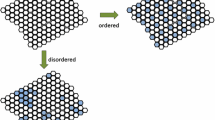Abstract
What is the coherence of organisms?
The problem of living organization can be stated as follows:
How is it that an organism consisting of a multiplicity of tissues and cells and astronomical numbers of molecules of many different kinds can develop and function as a whole?
Access this chapter
Tax calculation will be finalised at checkout
Purchases are for personal use only
Preview
Unable to display preview. Download preview PDF.
Similar content being viewed by others
References
Collins J.J., Stewart I.N.J. Math. Biol. 1992;30:827–838.
Bordas J., Diakun G.P., Diaz F.G., Harris J.E., Lewis R.A., Lowy J., Mant G.R., Martin-Gernandez M.L., Towns-Andrews E. Two-dimensional time-resolved X-ray diffraction studies of live isometrically contracting frog sartorius muscle. J. Musc. Res. Cell. Mot. 1993; 14:311–324.
Bruce A., Wallace D. Critical point phenomena: universal physics at large length scales. In: Davies P. (ed.). The New Physics. Cambridge University Press, Cambridge 1989:236–267.
Dekorsy T., Auer H., Waschke C., Bakker H.J., Roskos H.G., Kurz H. Emission of submillimeter electromagnetic waves by coherent phonons. Phys. Rev. Lett. 1995;74:738–741.
Denbigh K. G. The Thermodynamics of the Steady State. Malthuen & Co. Ltd., New York 1951.
Duffield N.G. Global stability of condensation in the continuum limit for Frohlich’s pumped phonon system. J. Phys. A. Math. Gen. 1988;21:625–641.
Fleming G.R., van Grondell R. The primary steps of photosynthesis. Physics Today 1994,2:48–55.
Fröhlich H. The biological effects of microwaves and related questions. Adv. Electronics and Electron. Phys. 1980;53:85–152.
Glauber R.J. Coherence and quantum detection. In: Glauber R.J. (ed.). Quantum Optics. Academic Press, New York 1969.
Granzier H.L.M., Myers J.A., Pollack G.H. Stepwise shortening of muscle fibre segments. J. Musc. Res. Cell. Mot. 1987;8:242–251.
Ho M.S., Stone T.A., Jerman I., Bolton J., Bolton H., Goodwin B.C., Saunders P.T., Robertson F., Brief exposure to weak static magnetic fields during early embryogenesis cause cuticular pattern abnormalities in Drosophila larvae. Physics in medicine and Biology 1992a;37:1171–1179.
Ho M.W., Xu X., Ross S., Saunders, P.T. (1992). Light emission and rescattering in synchronously develo** populations of early Drosophila embryos — evidence for coherence of the embryonic field and long range cooperativity. In: Popp F.A., Li K.H., Gu Q. (eds.). Recent Advances in Biophoton Research. World Scientific, Singapore 1992b:287–306.
Ho M.W., Lawrence M. Interference colour vital imaging — a novel noninvasive technique. Microscopy and Analysis 1993a;9:26. See also Ho M.W., Neural Network World 1995a; 5: 733-750.
Ho M.W. The Rainbow and the Worm: The Physics of Organisms. World Scientific, Singapore 1993b.
Ho M.W., Saunders P.T. Liquid crystalline mesophases in living organisms. In: Ho M.W., Popp F.A., Warnke U. (eds.). Bioelectromagnetism and Biocommunication. World Scientific, Singapore 1994a.
Ho M.W., Popp F.A., Warnke U. Bioelectrodynamics and Biocommunication. World Scientific, Singapore 1994c.
Ho M.W. What is (Schrödinger’s) negentropy? 3rd BTK Conference Proceedings, Innsbruck 1994b.
Ho M.W. (ed.). Bioenergetics, Living Processes, An Open University Third Level Science Course, Open University Press, Milton Keynes 1995b.
Ho M.W., French A., Haffegee J., Saunders P.T. Can weak magnetic fields (or potentials) affect pattern formation? In: Ho M.W., Popp F.A., Warnke U. (eds.). Bioelectrodynamics and Biocommunication. World Scientific, Singapore 1994d.
Iwazumi T. High-speed ultrasensitive instrumentation for myofibril mechanics measurements. Am. J. Physiol. 1987;252:C253–C262.
Kelso J.A.S. Behavioral and neural pattern generation: The concept of neurobehavioral dynamical systems. In: Koepchen H.P., Huopaniemi T. (eds.). Cardiorespiratory and Motor Coordination. Springer-Verlag, Berlin 1991:224–234.
Lumry R. Mechanical, force, hydration, and conformational fluctuations in enzyme catalysis. In: Kuby S.A. (ed.). A Study of Enzymes, vol.2, Mechanism of Enzyme Action. CRC Press, New Haven 1991.
McClare C.W.F. Chemical machines, Maxwell’s demon and living organisms. J. theor. Biol. 1971;30:1–34.
Morowitz H.J. Energy Flow in Biology. Academic Press, New York 1968.
Musumeci F., Godlevski M., Popp F.A., Ho M.W. Time behaviour of delayed luminescence in Acetabularia acetabulum In: Popp F.A., Li K.H., Gu Q. (eds.). Recent Advances in Biophoton Research. World Scientific, Singapore 1992:327–344.
Onsager L. Reciprocal relations in irreversible processes I and II. Phys. Rev. 1931;37:405–426 and 1931; 38: 2265-2279.
Popp F.A., Li K.H., Gu Q. (eds.). Recent Advances in Biophoton Research. World Scientific, Singapore 1992.
Popp F.A. On the coherence of ultraweak photoemission from living tissues. In: Kilmister C.W. (ed.). Disequilibrium and Self-Organization. Reidel, Dordrecht 1986:207.
Popp F.A., Li K.H. Hyperbolic relaxation as a sufficient condition of a fully coherent ergodic field. In: Popp F.A., Li K.H., Gu Q. (eds.). Recent Advances in Biophoton Research. World Scientific, Singapore 1992:47–58.
Prigogine I. Introduction to Thermodynamics of Irreversible Processes. Wiley & Sons, New York 1967.
Schrödinger E. What is Life? Cambridge University Press, Cambridge 1944.
Sewell G. Non-equilibrium statistical mechanics: dynamics of macroscopic observables. In: Gans H., Blumen A., Amann A. (eds.). Large-scale Molecular Systems: Quantum and Stochastic Aspects. Plenum Press, New York 1991.
Sole R.V., Miramontes O. Information at the edge of chaos in fluid neural networks. Physica D 1995;80:171–180.
Szent-Györgi A. An Introduction to Submolecular Biology. Academic Press, New York 1960.
Welch G.R. (ed.). Organized Multienzyme Systems. Academic Press, New York 1985.
Welch G.R., Berry M.N. Long-range energy continua and the coordination of multienzyme sequences in vivo. In: Welch G.R. (ed.). Organized Multienzyme Systems. Academic Press, New York 1985.
Yanagida T., Arata T., Oosawa F. Sliding distance of actin filament induced by a myosin crossbridge during one ATP hydrolysis cycle. Nature 1985;316:366–369.
Zhou Y.-M., Ho M.W., F.A. Popp, Q. Gu (1994). An oscillator cellular automaton model of superdelayed luminescence in synchronously develo** populations of early Drosophila embryos. In: Beloussov L., Popp F.A: (eds.). Non-Equilibrium and Coherent Systems in Biophysics. Biology and Biotechnology, Moscow (in press).
Editor information
Editors and Affiliations
Rights and permissions
Copyright information
© 1998 Springer Science+Business Media Dordrecht
About this chapter
Cite this chapter
Ho, MW. (1998). Bioenergetics and the Coherence of Organisms. In: Schulte, J., Endler, P.C. (eds) Fundamental Research in Ultra High Dilution and Homoeopathy. Springer, Dordrecht. https://doi.org/10.1007/978-94-011-5878-7_5
Download citation
DOI: https://doi.org/10.1007/978-94-011-5878-7_5
Publisher Name: Springer, Dordrecht
Print ISBN: 978-94-010-6484-2
Online ISBN: 978-94-011-5878-7
eBook Packages: Springer Book Archive



